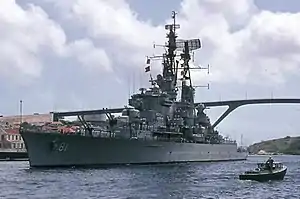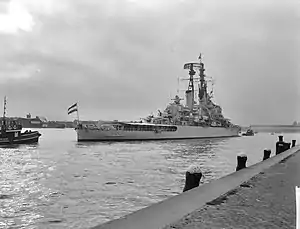BAP Almirante Grau (CLM-81)
BAP Almirante Grau (CLM-81) is a De Zeven Provinciën-class cruiser that served in the Royal Netherlands and Peruvian navies. Completed for the Dutch in 1953 as HNLMS De Ruyter (C801), she was acquired by Peru in 1973 and served as fleet flagship. Almirante Grau underwent a major modernization program between 1985 and 1988 during which she was fitted with new weapons and electronics. She was the last gun cruiser in service in any navy before being decommissioned on 26 September 2017. In 2019, it was announced that she would be preserved as a museum ship.
 BAP Almirante Grau (CLM-81) leaves the harbor of Curaçao, June 1973. | |
| History | |
|---|---|
| Name: | De Ruyter |
| Builder: | Wilton-Fijenoord, Schiedam |
| Laid down: | 5 September 1939 |
| Launched: | 19 December 1941 |
| Commissioned: | 18 November 1953 |
| Out of service: | Sold to Peruvian Navy in March 1973 |
| Name: | Almirante Grau |
| Namesake: | Admiral Miguel Grau Seminario |
| Acquired: | 7 March 1973 |
| Commissioned: | 23 May 1973 |
| Decommissioned: | 26 September 2017 |
| Homeport: | Callao |
| Motto: | Poder y Gloria (Power and Glory) |
| Fate: | To be preserved as a museum ship |
| General characteristics | |
| Class and type: | De Zeven Provinciën-class cruiser |
| Displacement: |
|
| Length: | 187.32 m (614.6 ft) |
| Beam: | 17.25 m (56.6 ft) |
| Draught: | 6.72 m (22.0 ft) |
| Draft: | 11.65 m (38.2 ft) |
| Propulsion: |
|
| Speed: | 32 kn (59 km/h; 37 mph) |
| Range: | 6,900 nmi (12,800 km; 7,900 mi) at 12 kn (22 km/h; 14 mph) |
| Complement: | 47 officers, 606 enlisted |
| Sensors and processing systems: | |
| Electronic warfare & decoys: |
|
| Armament: |
|
| Armor: |
|
Construction
De Ruyter was laid down by the Royal Netherlands Navy on 5 September 1939 as the cruiser HNLMS De Zeven Provinciën at the Wilton-Fijenoord shipyard at Schiedam.[1][2] She and her sister-ship, later De Zeven Provinciën, were intended to replace the two Java-class cruisers in the Dutch East Indies.[2] At the German invasion of the Netherlands in May 1940 little had been constructed. The Kriegsmarine intended to complete her as the training cruiser KH 1 but construction was slow and she was not launched until 24 December 1944, with the intent by then to use her as a blockship in the Nieuwe Waterweg, the approaches to Rotterdam.[1][2]
After the liberation of the Netherlands, the Navy completed De Zeven Provinciën with modifications, and she was commissioned as HNLMS De Ruyter (C801) on 18 November 1953.[1]
Royal Netherlands Navy service
In Dutch service both ships participated in several NATO exercises, and were frequently used as flagships for different naval task forces. Between 1962 and 1964, De Zeven Provinciën underwent a refit which included the removal of the two aft turrets and the installation of a RIM-2 Terrier SAM system, but lack of funds precluded the same modifications from being carried out in De Ruyter. After two decades in service, she was decommissioned on 16 October 1972.[2]
Peruvian Navy service
The Peruvian Navy bought De Ruyter on 7 March 1973[1] as a counter to the acquisition of the Swedish cruiser Göta Lejon by the Chilean Navy. Commissioned on 23 May 1973 as Almirante Grau, in honor of the Peruvian Admiral Miguel Grau, the ship arrived at her new homeport of Callao on 11 July 1973. She was designated fleet flagship in succession to another cruiser of the same name (the former HMS Newfoundland), which was renamed Capitán Quiñones.
Modernization
From 1985 until 1988, she underwent a major modernization program by Amsterdam Naval Services (ANS) at its shipyard in Amsterdam, during which she was denominated Proyecto de Modernización 01 (Modernization Project 01) or PM-01. Her role as flagship was assumed by her sistership Aguirre as Almirante Grau. Both ships regained their former names when the former De Ruyter returned to Callao on 15 February 1988.
The upgrade program carried out in the Netherlands included the following:
- Fitting of the Signaal SEWACO Foresee PE combat management system
- Fitting of a Signaal DA-08 surface-search radar
- Fitting of a Signaal LW-08 air-search radar
- Fitting of a Decca 1226 navigation radar
- Fitting of a Signaal STIR-24 fire-control radar
- Fitting of a Signaal WM-25 fire-control radar
- Fitting of two Signaal LIROD-8 optronic directors
- Fitting of the Signaal Rapids ESM system
- Fitting of the CME Scimitar ECM system
- Fitting of two Matra Défense Dagaie decoy launchers
- Fitting of one Matra Défense Sagaie decoy launcher
- Fitting of a Link Y data link
- Fitting (towers) of two Bofors signal amplifiers, including aiming and firing limitation
- Removal of four twin Bofors 57/60 mm gun mountings
- Removal of the CWE-610 hull sonar
Further work was carried out by SIMA dockyards in Callao as follows:
- Eight Otomat Mk 2 SSMs were fitted in 1993
- Two OTO Melara Twin 40L70 DARDO compact gun mountings were fitted in 1996, replacing four single Bofors 40/70 mm gun mountings
The LW-08 radar was later replaced by an AN/SPS-6, the former being installed in the frigate BAP Carvajal (FM-51) in 2003.[3]
Decommissioning
Almirante Grau was decommissioned on 26 September 2017. She was the last gun cruiser in service in any navy,[4] although its main armament was supplemented with Otomat anti-ship missiles.[4] She was replaced by the BAP Montero, now known as BAP Almirante Grau.
On August 9 2019, the Peruvian Navy announced that she would be preserved as a museum ship in Lima.[5]
Gallery
 HNLMS De Ruyter 1962
HNLMS De Ruyter 1962 Almirante Grau firing her guns
Almirante Grau firing her guns A stern view of BAP Almirante Grau from USS Pearl Harbor
A stern view of BAP Almirante Grau from USS Pearl Harbor BAP Almirante Grau 1993
BAP Almirante Grau 1993
References
- Moore, John, ed. (1980). Jane's Fighting Ships. 1980-1981. London: Jane's Pub. Co. p. 362. ISBN 978-0710607034.
- Visser, Jan. "Eendracht-class cruisers". Royal Netherlands Navy Warships of World War II. Retrieved 30 September 2017.
- Saunders, Stephen, ed. (2011). Jane's fighting ships 2011-2012. Coulsdon: IHS Jane's. ISBN 978-0710629593.
- Sanchez, Alejandro (26 September 2017). "Peruvian Navy designates new flagship". Jane's 360. IHS. Archived from the original on 28 September 2017. Retrieved 28 September 2017.
- http://maquina-de-combate.com/blog/?p=62509
Sources
- Baker III, Arthur D., The Naval Institute Guide to Combat Fleets of the World 2002-2003. Naval Institute Press, 2002.
- Rodríguez Asti, John, Cruceros. Buques de la Marina de Guerra del Perú desde 1884. Dirección de Intereses Marítimos, 2000. (in Spanish)
- van Dijk, A. (1988). "Re: The Dutch Shipbuilding Program of 1939". Warship International. XXV (3): 225. ISSN 0043-0374.
- van Dijk, Anthonie (1989). "Re: The Dutch Shipbuilding Program of 1939". Warship International. XXVI (2): 107. ISSN 0043-0374.
- Jane's Fighting Ships 2011-2012.
External links
| Wikimedia Commons has media related to BAP Almirante Grau (CLM-81). |